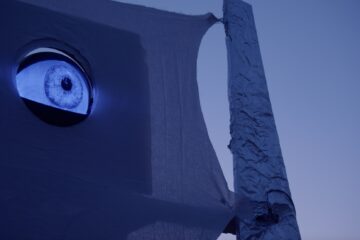Overview
- “Desert Artificial Arthropod” is a robot that is inspired by arthropods living in the desert. This robot aims at mimicking one of its most salient features – response to stimuli and hiding itself inside the burrow.
Concept
- With this project we wanted to create a model through which we can better understand the fauna in the desert, especially focusing on the arthropod subgroup in the desert. Typically arthropods are not the first thing that comes to your mind when you think of the fauna in the desert yet they occupy a very central and expansive role in the desert ecosystem. Thus, through this project we wanted to highlight this group of organisms. We are attempting to create an artificial arthropod that would focus on replicating the survival instincts of arthropods like desert beetles, desert spiders. To achieve this, we are building a robot that is able to walk through the desert landscape and reacts to different stimuli such as light, sound and vibration. Once it senses these stimuli, it hides in a borrow close by. After staying in the borrow for a stipulated amount of time, it resurfaces and then continues walking until it is stimulated again.
Relationship to previous work (e.g. inspiration from other artworks)
WaLTR robot designed by Dr. Kiju Lee from Texas A&M university moves on a flat surface with wheels which expand as legs when climbing up the stairs.
TurboQuad wheels that can operate as wheels and legs based on the mode.
Additionally, the following research paper inspired us to know more about the effects that desert degradation has on borrow dwelling organisms.
- Gavish-Regev E, Armiach Steinpress I, Salman INA, Segev N, Uzan A, Byun Y, Levy T, Aharon S, Zvik Y, Shtuhin R, Shapira Y, Majer M, Ganem Z, Zonstein S, Magalhaes ILF, Lubin Y. Five-Year Monitoring of a Desert Burrow-Dwelling Spider Following an Environmental Disaster Indicates Long-Term Impacts. Insects. 2022 Jan 17;13(1):101. doi: 10.3390/insects13010101. PMID: 35055943; PMCID: PMC8780495.
https://pubmed.ncbi.nlm.nih.gov/35055943/
Sketch Explaining the Proposed Work
[Prototype 1]
[Prototype 2]
Development (Planned technical implementation)
- Mechanics
- The mechanics of the model would involve motors that would be used to rotate the wheggos/wheels allowing for linear motion (or as close to it) on the desert landscape.
- The appropriate wheel design and shape will be confirmed after iterative testing.
- The body will consist of cardboard for the prototype and wood for the final model. The aim is to keep it lightweight so that it does not sink into the desert surface.
- We will also be designing the wheels such that it can move both front and back. To achieve this, we will be trying out a bi-blade wheel structure, to allow for the bidirectional movement.
- We also plan on having a servo in order to allow the model to rotate on its own axis. This will help us in directing it to the borrow.
- Sensors
- Overall:
- The sensors after processing the light and sound at constant intervals pass a message to the motors to go back to hiding once stimulus is sensed. After a given time interval the robot unhides itself, comes out of the burrow, and looks for the changes.
- In-Depth:
- Sensors continuously measure the ambient light and sound.
- We set a threshold based on the testing (we have to be able to differentiate slight changes from prominent ones)
- We set a delay upon testing (aid in differentiating slight changes from prominent ones)
- And if the value fluctuates up or down with a difference more than the threshold – then we trigger the motors to perform the necessary action – HIDE.
- Overall:
- Prototype
- For our first prototype, we plan to have the basic structure of the robot and a light sensor to get things going.
- For our second prototype, we shall include other sensors for mainly sound and improve and finalize the body structure, specially the wheels that are best suited for the desert environment (where there is sand, bushes are encountered, etc.)
Summary
- Arthropods are everywhere, yet their existence and ways of survival are often overlooked. This especially applies to arthropods in the desert, where living beings already seem nonexistent.
- Our “artificial desert arthropod” will be an educational, biomimetic toy that sheds light upon these invisible yet resilient lives in the desert.
- We will equip the robot with the necessary technical features of moving around and hiding inside the burrow in response to external stimuli. We are learning from previous robotics projects, examining different ways they’ve been built to move around. Through further research and experimentation, we hope to successfully emulate a desert arthropod with our robot.
Presentation
- Presentation Link
https://docs.google.com/presentation/d/1_oPbdST05KlD9ZHN6ukFMXsoinN7MGcZdXrgJrZUTdI/edit?usp=sharing
Group Members
Armaan Agrawal, Injoo Kang, Amy Kang, Sri Pranav Srivatsavai


